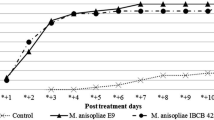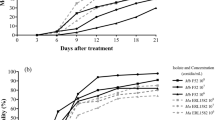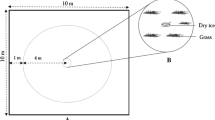Abstract
Metarhizium anisopliae sensu stricto (ss) (Metsch.) Sorok. isolate ICIPE 07 is being developed as biopesticide for the control of ticks. In addition, leaf extracts of Calpurnia aurea Benth, and the attraction aggregation and attachment pheromone (AAAP) are being used as ticks’ attractant. The three agents are being considered for use in combination in an autodissemination approach, whereby ticks that are attracted to semiochemicals are infected with the inoculum. Experiments were therefore conducted to evaluate in vitro the compatibility between C. aurea, AAAP, and the M. anisopliae on vegetative growth, conidial production, and spore viability. Calpurnia aurea leaf extract was compatible with the fungus at all the concentrations tested, whereas AAAP inhibited all the fungal growth parameters. The virulence of M. anisopliae formulated in emulsifiable extracts of C. aurea was also tested against different developmental stages of Rhipicephalus appendiculatus in laboratory bioassays. No significant differences in virulence were observed between M. anisopliae applied alone and M. anisopliae formulated in different concentrations of C. aurea leaf extracts. These results suggest that C. aurea leaf extracts is compatible with M. anisopliae and could be mixed together for “spot-spray” treatments as low-cost and environmental-friendly technology to control ticks in grazing field, while AAAP should be used separately.
Similar content being viewed by others
References
Abbott WS (1925) A method of computing the effectiveness of an insecticide. J Econ Entomol 18:265–267
Abolins S, Thind B, Jackson V, Luke B, Moore D, Wall R, Taylor MA (2007) Control of sheep scab mite Psoroptes ovis in vivo and in vitro using fungal pathogens. Vet Parasitol 148:310–317
Akbar W, Lord JC, Nechols JR, Loughin TM (2005) Efficacy of Beauveria bassiana for red flour beetle when applied with plant essential oils or in mineral oil and organosilicone carriers. J Econ Entomol 98:683–688
Alves SB, Moino Jr, Almeida JEM (1998) Produtos fitossanitarios entomopatogenos, p 217–238. In: Alves SB (ed) Contrôle microbiano de insetos. Piracicaba, FEALQ, p 1163
Anedja M, Gianfagna TJ, Hebbar PK (2005) Trichoderma harzianum produces nonanoic acid, an inhibitor of spore germination and mycelia growth of two cacao pathogens. PMPP 67:304–307
Angelo IC, Fernandes EKK, Bahiense TC, Pernotto WMS, Moraes APR, Terra ALM, Bittencourt VREP (2010) Efficiency of Lecanicillium lecanii to control the tick Rhipicephalus microplus. Vet Parasitol 172:317–322
Borgio JF, Bency BJ, Sharma N (2008) Compatibility of Metarhizium anisopliae (Metsch.) Sorok. with Ocimum sanctum Linn. (Tulsi) (Lamiaceae) extracts. Ethnobotanical Leaflets 12:698–704
Briggs LL, Colwell DD, Wall R (2006) Control of the cattle louse Bovicola bovis with the fungal pathogen Metarhizium anisopliae. Vet Parasitol 142:344–349
Burgerjon A (1956) Pulvérisation de poudrage au laboratoire par des préparations pathogènes insecticides. Ann Epiphyt 4:675–684
Depieri RA, Martinez SS, Jr OA Menezes (2005) Compatibility of the fungus Beauveria bassiana (Bals.) Vuill. (Deuteromycetes) with extracts of Neem seeds and leaves and the emulsifiable oil. Neotrop Entomol 34:601–606
Dimbi S, Maniania NK, Lux SA, Mueke JM (2004) Effect of constant temperatures on germination, radial growth and virulence of Metarhizium anisopliae to three species of African tephritid fruit flies. Biocontrol 49:83–94
Duarte A, Menendez JM, Triguero N (1992) Estudio preliminar sobre la compatilidad de Metarhizium anisopliae com algunos plaguicidas quimicos. Rev Baracoa 22:31–39
Eloff JN (1999) It is possible to use herbarium specimens to screen for antimicrobial components in some plants. J Ethnopharmacol 67:355–360
Faria MR, Wraight SP (2007) Mycoinsecticides and mycoacaricides: a comprehensive list with worldwide coverage and international classification of formulation types. Biol Control 43:237–256
Feng MG, Pu XY, Ying SH, Wang YG (2004) Field trials of an oil-based emulsifiable formulation of Beauveria bassiana conidia and low application rates of imidacloprid for control of false-eye leafhopper Empoasca vitis in southern China. Crop Prot 23(6):489–496
Graf JF, Gogolewski R, Leach-Bing N, Sabatini GA, Molento MB, Bordin EL, Arantes GJ (2004) Tick control: an industry point of view. Parasitology 129:427–442
Hassan SM, Dipeolu OO, Malonza MM (1994) Natural attraction of livestock ticks by the leaves of shrub. Trop Anim Prod 26:87–91
Hirose E, Nerves PMOJ, Zequi JAC, Martins LH, Paralta CH, AJr Moino (2001) Effect of biofertilizers and neem oil on the entomopathogenic fungi Beauveria bassiana (Bals.) Vuill. and Metarhizium anisopliae (Metsch.) Sorok. Braz Arch Biol Technol 44:409–423
Kaaya GP, Hassan S (2000) Entomogenous fungi as promising biopesticides for tick control. Exp Appl Acarol 24(12):913–926
Kaaya GP, Mwangi EN, Ouna EA (1996) Prospects for biological control of livestock ticks, Rhipicephalus appendiculatus and Amblyomma variegatum, using the entomogenous fungi Beauveria bassiana and Metarhizium anisopliae. J Invertebr Pathol 67:15–20
Lacey LA, Goettel MS (1995) Current developments in microbial control of insect pests and prospects for the early 21st century. Entomophaga 40:3–27
Lopez-Llorca LV, Olivares-Bernabeu C (1997) Growth inhibition of nematophagous and entomopathogenic fungi by leaf litter and soil containing phenols. Mycol Res 101:691–697
Malo AR (1993) Estudio sobre la compatibilidad del hongo Beauveria bassiana (Bals.) Vuill. Con formulaciones commerciales de funguicidas e insecticidas. Rev Colomb Entomol 19:151–158
Maniania NK, Nchu F, Ekesi S (2007) Fungal pathogen for biocontrol of ticks. In: Ekesi S, Maniania NK (eds) Use of entomopathogenic fungi in biological pest management. Research Signpost, Kerala, pp 275–294
Maranga RO, Hassanali A, Kaaya GP, Mueke JM (2003) Attraction of Amblyomma variegatum (ticks) to the attraction-agregation-attachment-pheromone with or without carbon dioxide. Exp Appl Acarol 29:121–130
Marques RP, Monteiro AC, Pereira GT (2004) Growth, esporulation and viability of entomopathogenic fungi under mediums with differents Nim oil (Azadirachta indica) concentrations. Ciência Rural 34:1675–1680
Mohan MC, Reddy NP, Uma K, Devi UK, Kongara R, Sharma HC (2007) Growth and insect assays of Beauveria bassiana with neem to test their compatibility and synergism. Biocontrol Sci Techn 17:1059–1069
Nana P, Maniania NK, Maranga RO, Boga HI, Kutima HL, Nchu F, Eloff JN (2010) Attraction response of adult Rhipicephalus appendiculatus and Rhipicephalus pulchellus (Acari: Ixodidae) ticks to extracts from Calpurnia aurea (Fabaceae). Vet Parasitol 174:124–130
Nchu F, Maniania NK, Toure A, Hassanali A, Eloff JN (2009) The use of a semiochemical bait to enhance exposure of Amblyomma variegatum (Acari: Ixodidae) to Metarhizium anisopliae (Ascomycota: Hypocreales). Vet Parasitol 160(3–4):279–284
Nchu F, Maniania NK, Hassanali A, Eloff JN (2010) Performance of a Metarhizium anisopliae-treated semiochemical-baited trap in reducing Amblyomma variegatum populations in the field. Vet Parasitol 169(3–4):367–372
Ndhlovu DN, Makaya PV, Penzhorn BL (2009) Tick infestation, and udder and teat damage in selected cattle herds of Matabeland South, Zimbabwe. Onderstepoort J Vet Res 76(2):235–248
Ostfeld RS, Price A, Hornbostel VL, Benjamin AB, Keesing F (2006) Controlling ticks and tick-borne zoonoses with biological and chemical agents. Bioscience 5:383–394
Pell JK, Eilenberg J, Hajek AE, Steinkraus DC (2001) Biology ecology and pest management potential of Entomophthorales. In: Butt TM, Jackson C, Magan N (eds) Fungi as biocontrol agents: progress, problems and potential. CAB International, Wallingford, pp 71–153
Razmi GR, Ebrahimzadeh E, Aslani MR (2003) A study about tick vectors of bovine theileriosis in an endemic region of Iran. J Vet Med 50:309–310
Roberts DW, Humber RA (1981) Entomogenous fungi. In: Cole GT, Kendrick WB (eds), vol. 2. Academic Press, New York, pp 201–236
Samish M, Gindin G, Alekseev E, Glazer I (2001) Pathogenicity of entomopathogenic fungi to different developmental stages of Rhipicephalus sanguineus (Acari: Ixodidae). J Parasitol 87:1355–1359
SAS Institute (2001) SAS/STAT User’s Guide: Version 6, 4th edn, vol 1, SAS Institute, Cary
Schulze TL, Jordan RA, Hung RW, Krivenko AJ, Schulze JJ, Jordan TM (2001) Effects of an application of granular carbaryl on nontargets forest floor arthropods. J Econ Entomol 10:149–154
Tavassoli M, Ownag A, Pourseyed SH, Mardani K (2008) Laboratory evaluation of three strains of the entomopathogenic fungus Metarhizium anisopliae for controlling Dermanyssus gallinae. Avian Pathol 37:259–263
Watt DM, Walker AR (2000) Pathological effects and reduced survival in Rhipicephalus appendiculatus ticks infected with Theileria parva protozoa. Parasitol Res 86:207–214
Zahid Iqbal R, Song-hua H, Wan-jun C, Abdullah GA, Chen-wen X (2006) Importance of ticks and their chemical and immunological control in livestock. J Zhejiang Univ Sci 7(11):912–921
Zorloni A, Penzhorn BL, Eloff JN (2010) Extract of Calpurnia aurea leaves from Southern Ethiopia attract and immobilise or killed ticks. Vet Parasitol 168(1–2):160–164
Acknowledgments
The first author received fellowship from the Bioscience Eastern and Central Africa Network (BecANet) and the Canadian International Development Agency (CIDA). The authors wish to thank BecANet, CIDA, icipe, and the curator of the Lowveld National Botanical Garden, who gave permission for the collection of plant material. The authors also extend their gratitude to the late Dr. A. Chabi, icipe, for reviewing the manuscript, and Ms Elizabeth Ouna and Ms Barbara Obonyo for their technical assistance.
Author information
Authors and Affiliations
Corresponding author
Additional information
Communicated by M. Brownbridge and M. Traugott.
Rights and permissions
About this article
Cite this article
Nana, P., Maniania, N.K., Maranga, R.O. et al. Compatibility between Calpurnia aurea leaf extract, attraction aggregation, and attachment pheromone and entomopathogenic fungus Metarhizium anisopliae on viability, growth, and virulence of the pathogen. J Pest Sci 85, 109–115 (2012). https://doi.org/10.1007/s10340-011-0399-5
Received:
Accepted:
Published:
Issue Date:
DOI: https://doi.org/10.1007/s10340-011-0399-5




